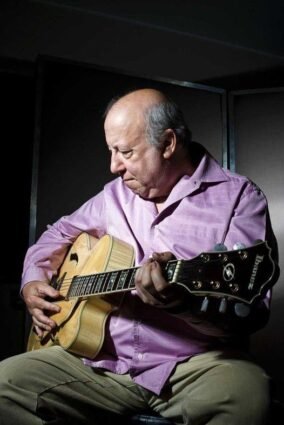
This is Peter Green.You may not recognize him today — he looks a lot different from the way he did in 1967, when at the age of 20 he became the founder and frontman for what would become one of the most successful and enduring acts in music history.
But when the band he created was selling millions of albums and playing to packed arenas, Green was long gone — destitute, homeless, and quite mad.
Peter Green had been a rising star in Britain’s blues revival of the 1960s. His guitar playing caught the attention of Bluesbreakers frontman John Mayall, who let the teenage Green sit in with the band when lead guitarist Eric Clapton was unavailable. When Clapton eventually left to form Cream, Mayall gave the job to Green, predicting that within a few years he would eclipse Clapton as England’s greatest blues guitarist.
After a year with Mayall, Green was eager to front his own band. He poached two of his Bluesbreakers bandmates, Mick Fleetwood and John McVie, enticing them to join by naming the band Peter Green’s Fleetwood Mac.
The band, which played a mix of blues standards and original compositions by Green, enjoyed overnight success. Behind Green’s soulful voice and raw, authentic guitar playing, their debut self-titled album, Fleetwood Mac, spent 37 weeks on the UK charts, and was the fourth best-selling album of the year. Green would quickly mature as a songwriter, charting with such compositions as Black Magic Woman (later a major hit for Santana) and the instrumental Albatross, which shot to No. 1.
As their fame and popularity increased, Green’s bandmates began to notice changes in his behavior. On a tour of Europe in 1970, Green abruptly left for several weeks to join a German commune where he ingested large quantities of LSD. His erratic behavior had intensified; he grew a beard and began wearing long robes and crucifixes, and spoke of his desire for the band to give away the money they’d earned. His compositions around this time became increasingly darker, as evidenced in his song The Green Manalishi (with the Two Prong Crown):
“Now, when the day goes to sleep and the full moon looks
The night is so black that the darkness cooks
Don’t you come creepin’ around – makin’ me do things I don’t want to
Can’t believe that you need my love so bad
Come sneakin’ around tryin’ to drive me mad
Bustin’ in on my dreams – making me see things I don’t wanna see“
Two months after his stay at the German commune, Green left Fleetwood Mac. He released a solo album the following year as well as sessions with B.B. King, and then faded into obscurity.
Broke and unable to care for himself, he moved into the home of his brother and sister-in-law, who encouraged him to seek psychiatric treatment. He was diagnosed with schizophrenia in the late 70s and began a long road to recovery. He was given anti-psychotic drugs which managed his symptoms, but according to Green, caused a complete loss of interest in music. So for the next several decades he went on and off the medication, a struggle which lasts to the present day.
He formed the Peter Green Splinter Group in 1997. The band released nine albums over the next eight years until Green abruptly disbanded the group.
He lives today in comfortable retirement in the south of England, looked after by close friends. Mick Fleetwood visited him several years ago and described the bittersweet day: “He’s still warm and kind, but otherwise he’s not the man I knew, clearly.”
It’s unclear whether the LSD Green took triggered his underlying schizophrenia or merely exacerbated it, but one thing seems clear: had he remained healthy, Peter Green would likely have become one of the most influential recording artists of all time.
Sadly, many people who read this post have probably never heard of him.
